The Death of Enterprise Architecture
Blog: Brian's Blog - Enterprise Strategy, Architecture and Management
 This morning I read a rather despondent post by a peer seemingly on the verge of giving up Enterprise Architecture. Not a particularly happy thought. It was reminiscent of the death knells I heard a few decades ago and seems to repeat each decade.
This morning I read a rather despondent post by a peer seemingly on the verge of giving up Enterprise Architecture. Not a particularly happy thought. It was reminiscent of the death knells I heard a few decades ago and seems to repeat each decade.
At that time large corporations had just come off of a great high on Strategic Planning, Enterprise Architecture, and other master planning activities. There was a great trough of disillusion regarding any planning activities. Comments like “things are always changing, so planning is a waste”; “you can’t plan for everything”; and other criticisms of planning and design were popular in the culture.
Such comments resonate well in the cowboy culture of American Business; except when it comes to production where tremendous efforts to plan resource utilization are common. Look at the success of ERP software as an example.
My thoughts on ERP mega-success verses other Design and Planning software moderate success draws me to the conclusions I had back during the first trough of disillusion. At that time “Architecture Practice”, that is the design of physical dwellings, had hit a slump or rather a restructuring. I had been informed a career in designing buildings was going to be a difficult undertaking as investment in construction had dropped and one of the cost cutting measures development organizations and people were taking was to reuse designs (patterns and practices) rather than create or customize to individual preferences. The perceived cost verses the benefits of hiring an architect were not in balance. As such the question I had for my advisors: Will I be on a street corner with a sign “Will design a house for food” seemed poignant.
Fast forward to today. Many of my peers back then left the profession within two to four years seeing that the industry restructuring had reduced the capacity of resources needed to meet demand.
There are strong parallels to today. With the advent of best practices, templates, etc. the needed capacity for parametric designers (i.e., template completion staff) has reduced. As such the role in EA has more and more become closely associated with IT presales and support. This maybe because of its origins in information technology presales and support.
Whether this is good or bad is up for discussion. On the positive side such roles enable one to learn and develop soft skills working with line of business and possibly executive management. On the negative side it often constrains one to focusing on the technology aspects of an enterprise. Those thoughts of working to define the business are often far from reach. Your role is to translate business capabilities defined by the business design into technology requirements, determine which technology is most appropriate, or defined implementation details.
Notice I did not mention defining the business or business model. Until you are in the inner circle of Executive or Line of Business Management you are unlikely to be given the opportunity to define or influence the business design. If lucky, you’ll be asked to document the business model. This would be the entre into business design. From there if you can provide insight and value regarding the business model choices from other than a technology perspective you may be invited into the inner circle as an “intern”.
The thing to remember here is that, its their business, not yours. You’ve been invited to give insight, not criticize or make decisions. Unlike Frank Lloyd Wright you don’t have a successful brand as a business designer, that enables you to dictate all the aspects of a design your client will have to accept if s/he wants a “Frank Lloyd Wright” House. The closest to such defined business models that owners accept as given would be franchises like Mc Donald’s, etc. There the business model has reached into the best practices, Patterns and Practices level.
So what does that say about Enterprise Architecture and where it should report to? Yes, designing the business is possible, but it will take time and effort to gain trust to be given those opportunities. Understanding your role as a translator of business capabilities to technology will likely be the core of your practice. While business model design and definition will be needed stills, the freedom to change these are not often granted.
Filed under: Enterprise Architecture
![]()
Leave a Comment
You must be logged in to post a comment.







